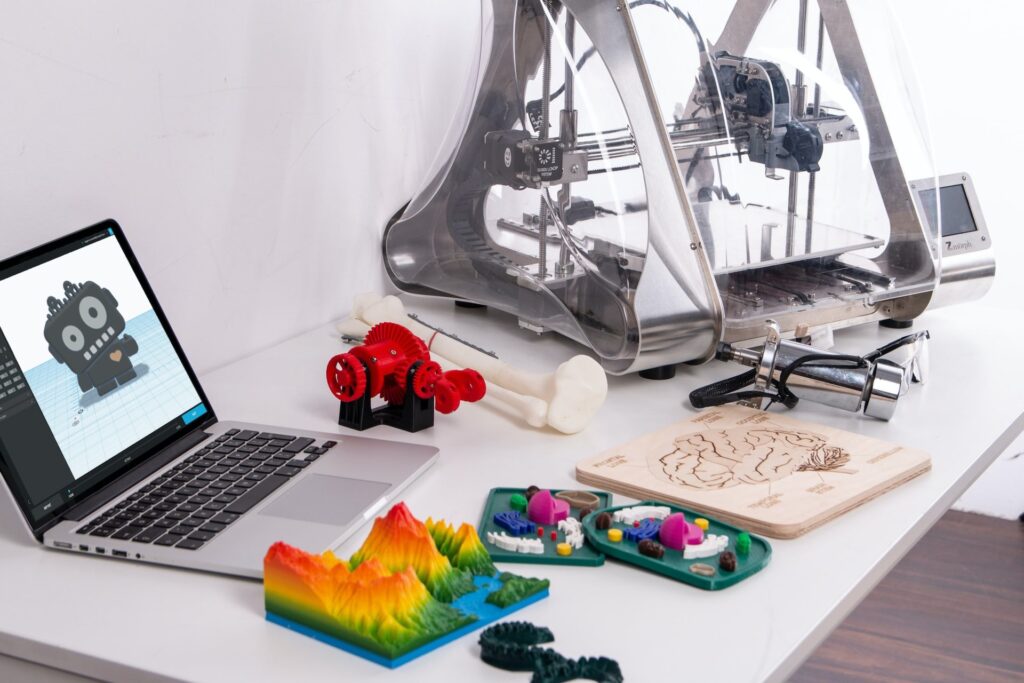Revolutionizing Creation: An Introduction to 3D Printers and 3D Printing
In the realm of technology and innovation, few advancements have captured the imagination quite like 3D printing. Often referred to as additive manufacturing, this groundbreaking technology has introduced a new era of creative possibilities, transforming the way we conceptualize, design, and produce objects. From rapid prototyping to intricate artistic creations, 3D printers have woven a tapestry of innovation that is reshaping industries and inspiring individuals around the globe.
The Essence of 3D Printing: Unveiling the Concept
At its core, 3D printing is a method of creating physical objects from a digital design by adding material layer by layer. This is in stark contrast to traditional subtractive manufacturing methods where material is cut away from a solid block to shape the desired object. The process begins with a three-dimensional digital model created using computer-aided design (CAD) software or acquired through 3D scanning technologies. This digital model serves as a blueprint for the 3D printer to understand how to construct the physical object.

The Dance of Technology: How 3D Printers Work
The magic of 3D printing unfolds through the intricate dance of technology that takes place within a 3D printer. Imagine a printer that doesn’t just apply ink onto paper, but intricately builds up layer upon layer of material to craft a tangible object. This is the essence of a 3D printer.
The process involves several key components:
- Digital Design: A 3D model is created or obtained using CAD software or 3D scanning technologies. This model defines the geometry and specifications of the object to be printed.
- Slicing: The 3D model is “sliced” into thin horizontal layers using slicing software. This creates a set of instructions that the 3D printer will follow, indicating where to deposit material for each layer.
- Material Deposition: The chosen material, which can range from plastics and metals to ceramics and even food, is fed into the 3D printer in its raw form. The printer’s nozzle or extruder then deposits the material layer by layer according to the slicing instructions.
- Layer Bonding: As each layer of material is deposited, it bonds with the previous layer through various methods such as melting, curing, or fusing. This creates a cohesive and solid structure.
- Building Up: The printer continues the layer-by-layer process until the entire object is created. This additive manufacturing process allows for complex and intricate designs that might be difficult or impossible to achieve through traditional manufacturing methods.
A Symphony of Applications: The Reach of 3D Printing
The versatility of 3D printing has unleashed a symphony of applications across various fields:
- Prototyping and Product Development: Industries ranging from automotive to aerospace use 3D printing for rapid prototyping, enabling faster iterations and cost-effective design testing.
- Medicine and Healthcare: 3D printing has revolutionized the medical field, producing custom implants, prosthetics, surgical guides, and even human tissue and organs.
- Art and Design: Artists and designers embrace 3D printing for pushing the boundaries of creativity, crafting intricate sculptures, jewelry, and avant-garde fashion.
- Education: 3D printing is a powerful educational tool, allowing students to grasp complex concepts through tangible, hands-on experiences.
- Consumer Goods: From customizable phone cases to unique home decor items, 3D printing is making personalization more accessible.
- Food: Culinary enthusiasts and professional chefs experiment with 3D-printed food designs, creating intricate edible structures.
Challenges and Future Horizons
While 3D printing holds immense promise, there are challenges to overcome, such as material limitations, production speed, and quality control. However, ongoing research and technological advancements are steadily addressing these issues.
As we gaze into the future, 3D printing is poised to become an even more integral part of our lives. The potential for sustainable manufacturing, on-demand production, and innovative design solutions is boundless. As the technology evolves, it will likely continue to democratize creation, empowering individuals and industries to bring their ideas to life in ways that were once only dreamed of.
In conclusion, 3D printing stands as a testament to human ingenuity, a bridge between the digital and physical worlds that redefines how we conceive, craft, and interact with objects. This technology’s journey from niche innovation to mainstream marvel underscores its significance in shaping the future of production, design, and imagination.
Listings related to article "Revolutionizing Creation: An Introduction to 3D Printers and 3D Printing"
OpenTeQ
OpenTeQ’s technology consulting services guide you through your transformation journey, leveraging design, technology, and agility.
- Category
- Computers » Software » Development Companies
Chicago Permanent Makeup – Microblading by Agatha
Experience the expertise of Agatha, a skilled artist in the realm of everlasting beauty. With a passion for perfection, she offers a comprehensive range of services that include professional permanent makeup for eyebrows, eyeliners, and lips, as well as the intricate artistry of eyebrow microblading.
Art Kitchen Direct for Chicago Builders and Developers
Introducing Kinzini, the go-to destination for comprehensive kitchen services tailored exclusively for builders and developers in Chicago. With a meticulous approach from start to finish, they specialize in crafting exceptional kitchens, vanities, and closets that surpass industry standards.
- Category
- Home » Home Improvement » Kitchens
More articles like "Revolutionizing Creation: An Introduction to 3D Printers and 3D Printing"
Conway’s Law: Understanding the Deep Connection Between Software Design and Organizational Structure
Conway’s Law, proposed by computer programmer and researcher Melvin Conway in 1968, is a fascinating observation that sheds light on the intricate relationship between software design and the structure of the organizations that create them. It highlights how the communication patterns and dynamics within a team or company significantly influence the architecture and design of […]
Unlocking New Perspectives: The Power of Vertical Monitors
In the ever-evolving world of technology, innovations continually reshape the way we work, play, and interact with our digital devices. One such innovation that has gained popularity among professionals, gamers, and enthusiasts alike is the vertical monitor. Breaking free from the traditional landscape orientation, a vertical monitor offers a refreshing twist, unlocking new perspectives and […]
Demystifying Data Science: Unleashing the Power of Insights
The article “Demystifying Data Science: Unleashing the Power of Insights” explores the multidisciplinary nature of data science and its transformative impact on industries worldwide. It discusses the key components and methodologies involved in data science, including mathematics and statistics, computer science and programming, and domain knowledge. The article highlights the standardized workflow of data science projects, from problem formulation to model deployment and monitoring. It also provides real-world examples of data science applications in healthcare, finance, marketing, transportation, and social sciences. The article concludes by discussing the future of data science, emphasizing the increasing demand for skilled data scientists and the role of emerging technologies. Overall, data science is portrayed as a powerful discipline that enables organizations to unlock hidden patterns and gain valuable insights, driving innovation and shaping a data-driven future.







